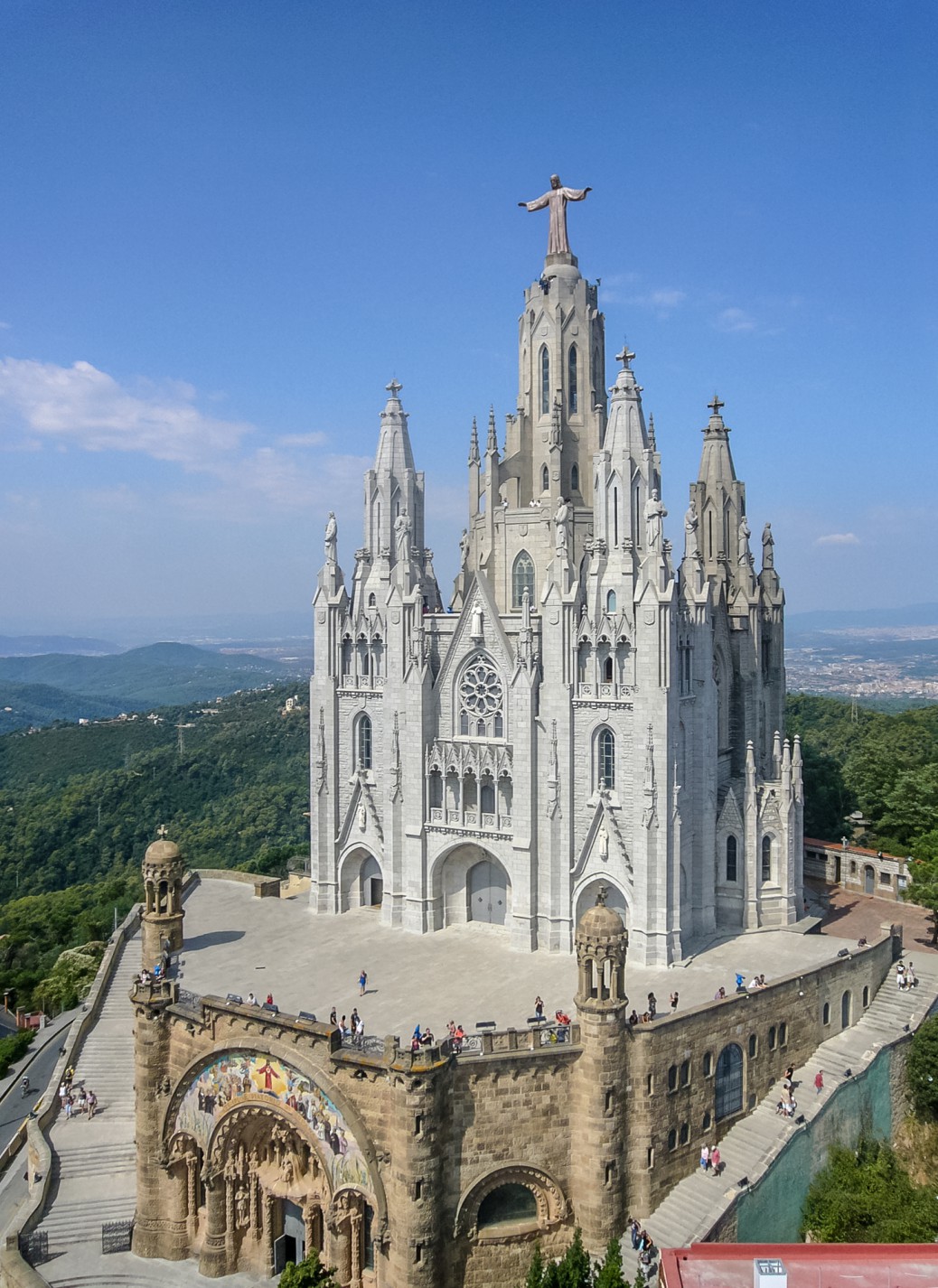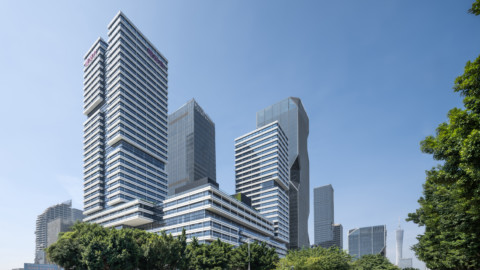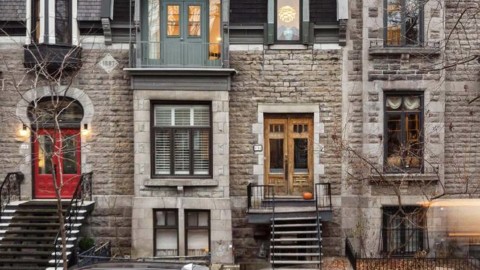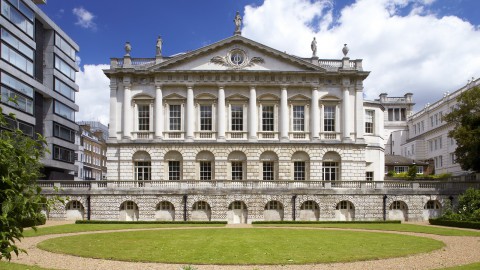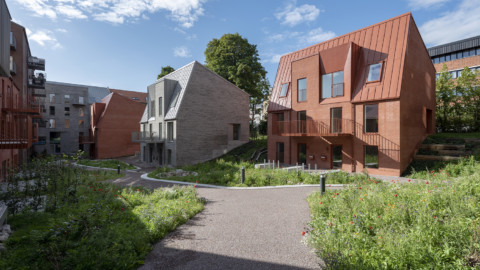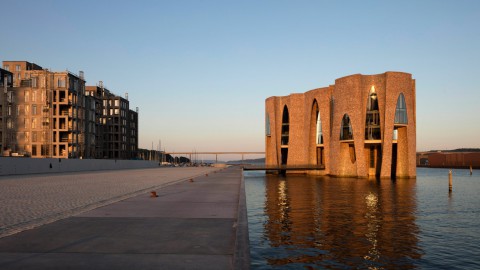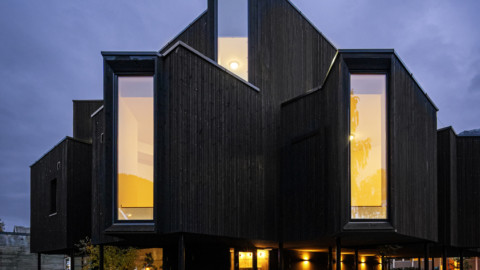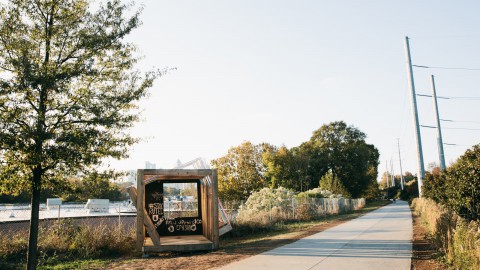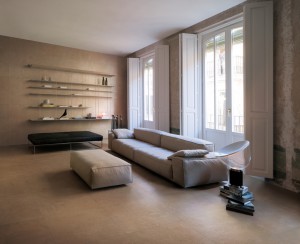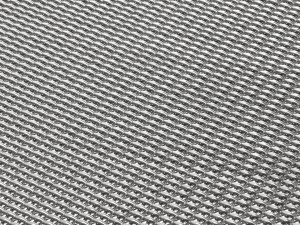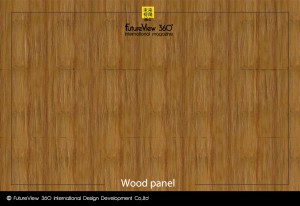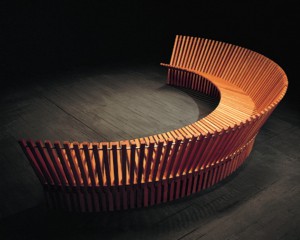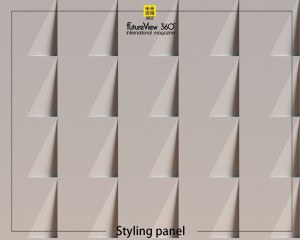Temple of the Sacred Heart of Jesus 聖心聖殿
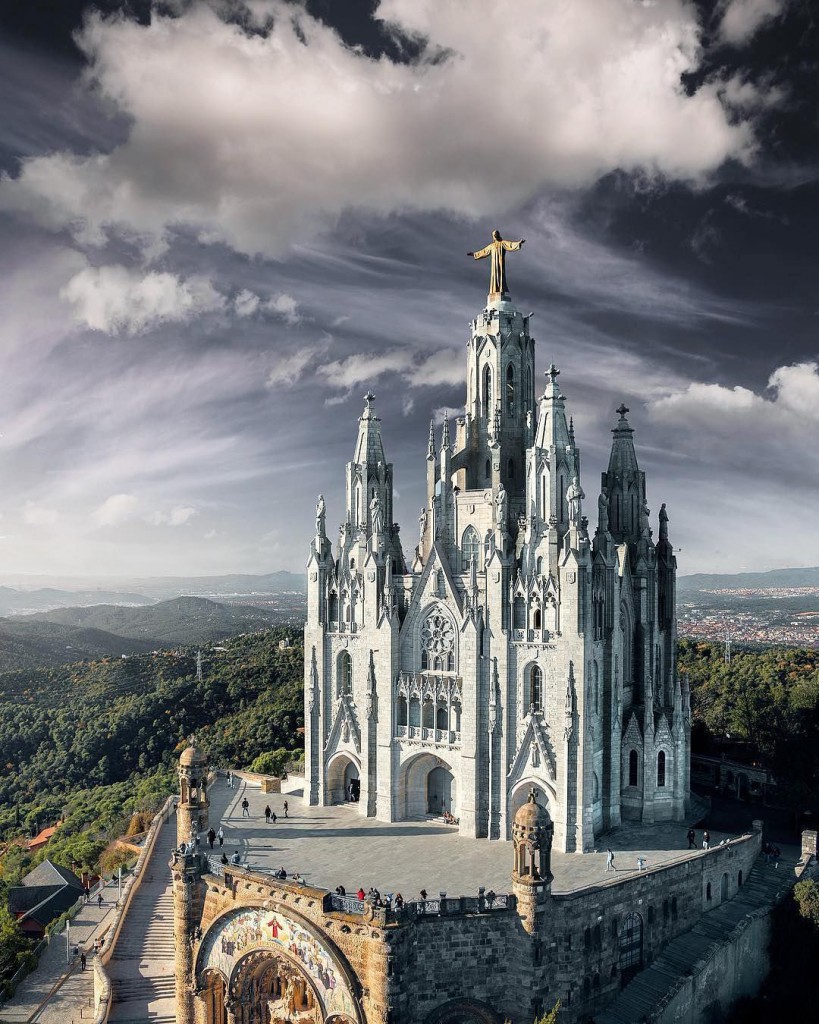
The Temple Expiatori del Sagrat Cor (Catalan pronunciation: [səˈɣɾat ˈkɔɾ]; English: Expiatory Church of the Sacred Heart of Jesus, Spanish: Templo Expiatorio del Sagrado Corazón de Jesús) is a Roman Catholic church and minor basilica located on the summit of Mount Tibidabo in Barcelona, Catalonia, Spain. The building is the work of the Spanish architect Enric Sagnier and was completed by his son Josep Maria Sagnier i Vidal. The construction of the church, dedicated to the Sacred Heart of Jesus, lasted from 1902 to 1961.
The Temple Expiatori del Sagrat Cor(加泰羅尼亞語發音:[səɣɾatkɔɾ];英語:耶穌聖心贖罪教堂,西班牙語:Templo Expiatorio delSagradoCorazóndeJesús)是一座羅馬天主教堂和位於山頂的小教堂 Tibidabo在巴塞羅那,加泰羅尼亞,西班牙。 該建築是西班牙建築師Enric Sagnier的作品,由他的兒子Josep Maria Sagnier i Vidal完成。 致力於耶穌聖心的教堂建築歷時1902年至1961年。
Religion
Affiliation:Roman Catholic
Ecclesiastical or organizational status:parish church, minor basilica
Year consecrated:1952
Location
Location:Barcelona, Catalonia, Spain
Geographic coordinates:41°25′19.47″N 2°7′7.9″ECoordinates: 41°25′19.47″N 2°7′7.9″E
Architecture
Architect(s):Enric Sagnier
Architectural type:Church
Architectural style:Neo Gothic
Groundbreaking:1902
Completed:1961
Specifications
Direction of façade:S
Length:60 metres (200 ft)
Width:70 metres (230 ft)
Spire(s):5
宗教
隸屬:羅馬天主教徒
教會或組織地位:教區教堂,小教堂
奉獻年份:1952年
地點
地點:巴塞羅那,加泰羅尼亞,西班牙
地理坐標:41°25’19.47“N 2°7’7.9”ECoordinates:41°25’19.47“N 2°7’7.9”E
建築
建築師:Enric Sagnier
建築類型:教堂
建築風格:新哥特式
開工:1902
完成時間:1961年
產品規格
立面方向:S
長度:60米(200英尺)
寬度:70米(230英尺)
尖頂(S):5
History
The idea of building a Catholic church on the summit of the Mount Tibidabo emerged in the late 19th century amidst rumors about the construction of a Protestant church and a hotel-casino at that location. This motivated a “Board of Catholic Knights” to acquire the ownership of the field and give it to Saint John Bosco in 1886, when he was visiting Barcelona at the invitation of Dorotea de Chopitea, a great patron and promoter of the project. From this arose the idea of a building dedicated to the Sacred Heart of Jesus, a dedication very popular at that time thanks to the impetus given by Pope Leo XIII, and following in line with the church built in Rome by Bosco himself (Sacro Cuore di Gesù a Castro Pretorio) and the famous Sacré-Cœur in Paris.
In 1886 a neo-Gothic hermitage was built, and two years later, for the Universal Exposition, the Vallvidrera road was urbanized and a pavilion of Mudejar inspiration was built beside the hermitage to serve as a viewing point (for the city below). However, the project to build the church suffered a significant delay mainly because of the development of a new project to build an astronomical observatory on the summit of Tibidabo, which was eventually constructed on a nearby hill (Fabra Observatory). Finally, on 28 December 1902, the first stone was placed in a ceremony presided by the Bishop of Barcelona, Salvador Casañas i Pagès.
The crypt was built between 1903 and 1911, and the main church was built between 1915 and 1951. The church was consecrated by Bishop Gregorio Modrego Casaus during the 35th Eucharistic Congress held in Barcelona in 1952. The towers were completed afterward, with work officially ending in 1961. On 29 October 1961 the church received the title of minor basilica from Pope John XXIII.
歷史
在Tibidabo山頂建造天主教堂的想法出現在19世紀晚期,有傳言說在該地點建造了新教教堂和酒店賭場。這促使一個“天主教騎士委員會”獲得該領域的所有權,並於1886年在聖托馬克應邀參加該項目的讚助人和推動者Dorotea de Chopitea的邀請下將其交給巴塞羅那。由此產生了一座致力於耶穌聖心的建築的想法,由於教皇利奧十三世的推動,並且遵循博斯科自己在羅馬建造的教堂(Sacro Cuore di),當時非常受歡迎。 GesùaCastro Pretorio)和巴黎著名的Sacré-Cœur。
1886年建造了一座新哥特式修道院,兩年後,為了世界博覽會,Vallvidrera公路被城市化,並且在冬宮旁邊建造了Mudejar靈感的亭子作為觀察點(對於下面的城市)。然而,建造教堂的項目遭受了重大延誤,主要是因為在Tibidabo峰頂建造了一個天文觀測台的新項目,該項目最終建在附近的一座山上(法布拉天文台)。最後,1902年12月28日,第一塊石頭被放置在由巴塞羅那主教薩爾瓦多·卡薩尼亞斯·帕格斯主持的儀式上。
地下室建於1903年至1911年,主教堂建於1915年至1951年。教堂由主教Gregorio Modrego Casaus在1952年在巴塞羅那舉行的第35屆聖體聖事會期間奉獻。塔樓隨後完工,工作正式結束1961年10月29日,教堂獲得了教皇約翰二十三世的小教堂稱號。
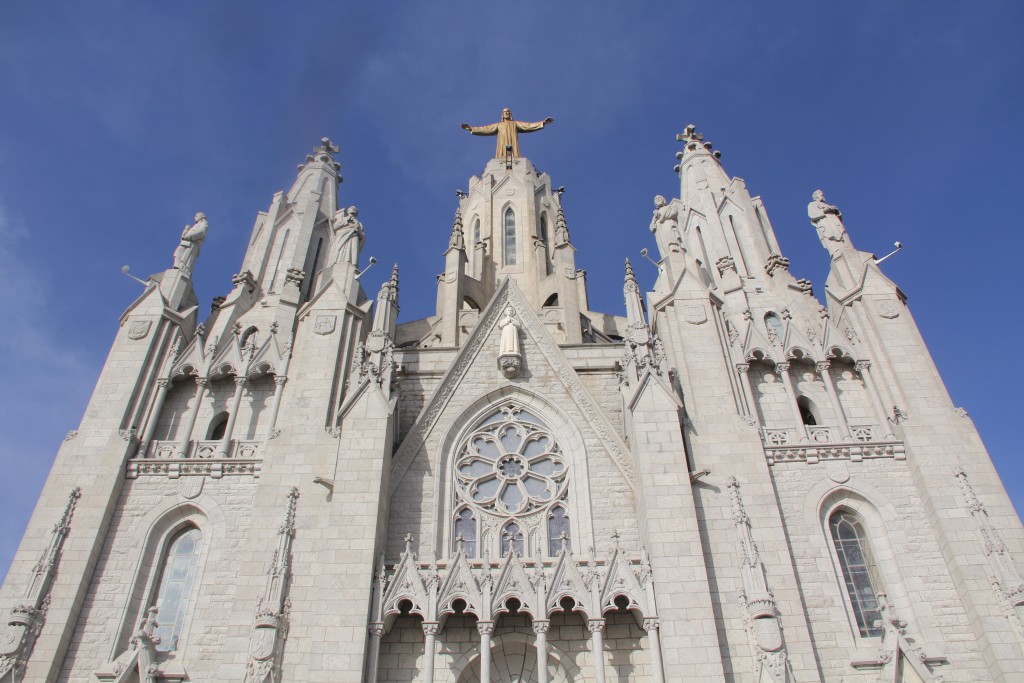
Exterior
The external appearance of the church is of a Romanesque fortress of stone from Montjuïc (the crypt), topped by a monumental neo-Gothic church accessed by two grand outdoor stairways. The upper church has a central floor with an octagonal dome on eight columns. The dome is crowned with an image of the Sacred Heart; the original work was by Frederic Marès (destroyed in 1936) and replaced in 1950 with another by Josep Miret.
The upper church is square with three apses, a large central tower, and four lower towers marking the four corners of the square, and statues of the Twelve Apostles sculpted by Josep Miret. The main facade has three sections, the central wider, chaired by the figure of the Archangel Michael in the arch of the main entrance, and John Bosco in the pediment above. Over the left door is the statue of Teresa of Ávila and over the right, Marguerite Marie Alacoque. Above the door is an open gallery of arches with tracery.
The façade of the crypt has a richly decorated tympanum with sculptures by Alfons Juyol i Bach following the design of Eusebi Arnau. The sculptures represent the Virgin of Mercy, Saint George, and Saint James, the patron saints of Barcelona, Catalonia, and Spain, respectively. The crypt facade consists of three semicircular arches on columns, inserted under a larger semicircular arch, originally decorated with a mosaic of the Holy Trinity by Daniel Zuloaga (destroyed in 1936). In 1955 it was redecorated by the Bru Workshop of Barcelona; the work depicts an allegory of the devotion of Spain, represented by its patron saints.
外觀
教堂的外觀是Montjuïc(地下室)的羅馬式石頭堡壘,頂部是一座巨大的新哥特式教堂,由兩個宏偉的戶外樓梯進入。上層教堂的中央樓層有八個圓柱形的八角形圓頂。穹頂上刻有聖心的形象;原作是FredericMarès(1936年被摧毀),1950年由Josep Miret取代。
上層教堂是正方形,有三個拱門,一個大型中央塔樓,四個標誌著廣場四角的低塔,以及由Josep Miret雕刻的十二使徒雕像。主立面有三個部分,中央較寬,由主入口拱門中的天使長邁克爾的形象和上面山形牆的約翰博斯科主持。在左邊的門是阿維拉的特雷莎雕像和右邊的瑪格麗特瑪麗阿拉科克。門的上方是一個帶有窗飾的拱門。
地窖的外觀有一個裝飾華麗的鼓室,Alfons Juyol i Bach的雕塑遵循Eusebi Arnau的設計。這些雕塑分別代表著慈悲聖母,聖喬治和聖詹姆斯,分別是巴塞羅那,加泰羅尼亞和西班牙的守護神。地下室立柱由三個圓柱形拱門組成,插入一個較大的半圓拱形,最初由Daniel Zuloaga(1936年摧毀)的三位一體馬賽克裝飾。 1955年,巴塞羅那Bru工作室重新裝修;這部作品描繪了西班牙奉獻精神的寓言,以其守護神為代表。
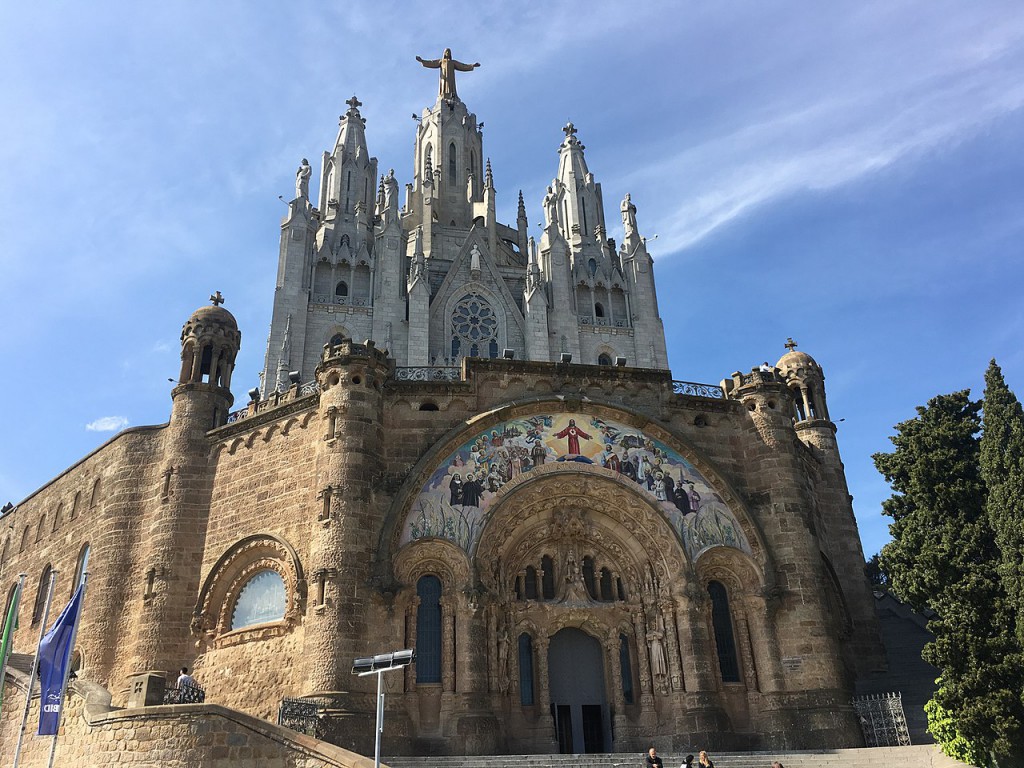
Interior
The interior is divided into a nave and two aisles with semicircular apses, with stained glasses and four rose windows on the facades. In the main altar stands the great crucifix, a work by Joan Puigdollers. The windows of the presbytery are dedicated to Pius X, John the Evangelist, Marguerite Marie Alacoque, Paul the Apostle and John Bosco. The left altar has five stained glasses dedicated to various Marian devotions: the Virgin of Antipolo (Philippines), Our Lady of Luján (Argentina), the Assumption of Mary, Our Lady of Guadalupe (Mexico) and Our Lady of Charity (Cuba). The right altar is presided by the Risen Jesus, a work by Joan Puigdollers, and its stained glasses are dedicated to Spanish Marian devotions: the Virgin of Almudena (Madrid), the Virgin of Núria (Catalonia), Our Lady of Hope, Our Lady of the Forsaken (Valencia) and Our Lady of Begoña (Basque Country).
The windows of the four towers contain the Latin phrase tibi dabo (“I’ll give you”), the name of the mountain. At the level of the choir include founding saints: Marcellin Champagnat and Jean-Baptiste de La Salle on both sides of the presbytery, and Anthony Mary Claret, Joseph Calasanctius, John Bosco and Maria Domenica Mazzarello next to the main facade. The windows of the four facades are dedicated to Francis de Sales, Pius XI, Ignatius of Loyola, Francisco Javier, Pius IX, Rose of Lima, Leo XIII and Pius XII. The eight stained glasses of the dome depict scenes from the life of Jesus.
內部
內部分為中殿和兩個帶有半圓形的過道,前面有彩色眼鏡和四個玫瑰窗。在主祭壇上矗立著巨大的十字架,這是Joan Puigdollers的作品。長老會的窗戶是獻給Pius X,John the Evangelist,Marguerite Marie Alacoque,Paul the Apostle和John Bosco。左邊的祭壇上有五個彩色眼鏡,專門用於各種瑪麗安的奉獻:聖保羅(菲律賓),聖母盧安(阿根廷),聖母升天,瓜達盧佩聖女(墨西哥)和聖母慈善(古巴)。右邊的祭壇由複活的耶穌主持,是Joan Puigdollers的作品,其彩色眼鏡專門用於西班牙瑪麗安的奉獻:阿爾穆德納(馬德里)的聖母,Núria的聖母(加泰羅尼亞),聖母的希望,聖母被遺忘者(瓦倫西亞)和聖母貝戈尼亞(巴斯克地區)。
四座塔樓的窗戶包含拉丁語短語tibi dabo(“我會給你”),這是山的名字。合唱團的級別包括創始人聖徒:Marcellin Champagnat和Jean-Baptiste de La Salle兩側的長老會,以及Anthony Mary Claret,Joseph Calasanctius,John Bosco和Maria Domenica Mazzarello在主立面旁邊。四個立面的窗戶專門用於Francis de Sales,Pius XI,Loyola的Ignatius,Francisco Javier,Pius IX,利馬玫瑰,Leo XIII和Pius XII。圓頂上的八個彩色眼鏡描繪了耶穌生平的場景。

Statue of Jesus
The church is crowned by the enormous bronze statue of the Sacred Heart made by Josep Miret in 1950, replacing the original made by Frederic Marès in 1935, and destroyed the following year. The ascent from the crypt, passing through the church and ending at the sculpture, reflects the rise and the purification of the human condition by means of sacrifice and atonement.
耶穌的雕像
教堂由Josep Miret於1950年製作的巨大的聖心青銅雕像加冕,取代了弗雷德里克·馬雷斯於1935年製作的原始雕像,並於次年摧毀。 從地窖上升,穿過教堂並在雕塑處結束,通過犧牲和贖罪來反映人類狀況的興起和淨化。
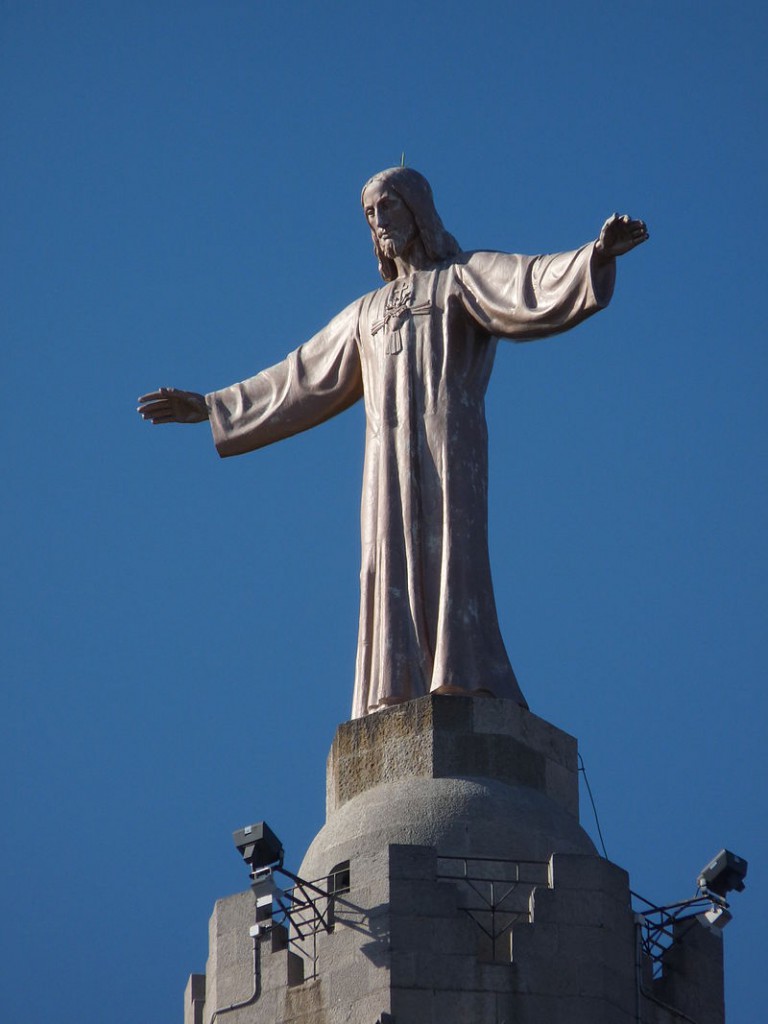
Crypt
The crypt was designed in a neo-Byzantine style, combining Gothic and classical elements, and decoration close to Modernisme. The space of the crypt consists of five naves separated by columns, the central one being wider, all with semicircular apses. The walls and vaults are lined with alabaster or decorated with mosaics, with scenes relating to the dedications of the altars: Mary Help of Christians, Saint Anthony of Padua, the Blessed Sacrament, Saint Joseph, and the Virgin of Montserrat.
Polychrome alabaster is also used for the Via Crucis (Stations of the Cross) sculpted by Josep Miret. The windows that bring natural light inside are complemented by stained glass windows with the following topics: the largest in the arch, in the corners, represent the appearance of the Our Lady of the Pillar and the conversion of King Reccared I to Catholicism; Saint Ferdinand and Saint Hermenegild are represented in the two large vertical windows; and the small ones located above the door are dedicated to Joachim, Isidore the Farmer, Saint Anthony and Saint Elizabeth of Portugal.
From the crypt there is access to a chapel dedicated to the Perpetual Adoration, excavated into the mountain in the late 1940s, consisting of three naves divided by columns. The interior is decorated with marble, mosaics in the pavement, and paintings by Miquel Farré i Albagés in the vaults, made between 1947-1949.
Outside of the crypt, on either side of the main door, are two staircases leading to the level of the temple itself.
地穴
地下室採用新拜占庭風格設計,結合了哥特式和古典元素,以及靠近Modernisme的裝飾。地穴的空間由五個由列分隔的中心組成,中央的一個更寬,都是半圓形的。牆壁和拱頂兩旁是雪花石膏或用馬賽克裝飾,場景與祭壇的奉獻有關:基督徒的瑪利亞幫助,帕多瓦的聖安東尼,聖體聖事,聖約瑟夫和蒙特塞拉特聖母。
多彩雪花石膏也用於由Josep Miret雕刻的Via Crucis(十字架站)。內部帶有自然光線的窗戶配有彩色玻璃窗,其中包括以下主題:拱門中最大的,在角落裡,代表著我們的支柱聖母的外觀以及將我馴養的國王轉變為天主教; Saint Ferdinand和Saint Hermenegild在兩個大型垂直窗戶中出現;位於門上方的小門專用於Joachim,Isidore the Farmer,Saint Anthony和Saint Elizabeth of Portugal。
從地下室可以進入一個專門用於永久崇拜的小教堂,該教堂於20世紀40年代後期被挖掘出來,由三個中殿分隔而成。室內裝飾有大理石,人行道上的馬賽克,以及MiquelFarréiAlbagés在1947年至1949年間建造的金庫中的畫作。
在主門兩側的地下室外面是兩個通往寺廟水平的樓梯。
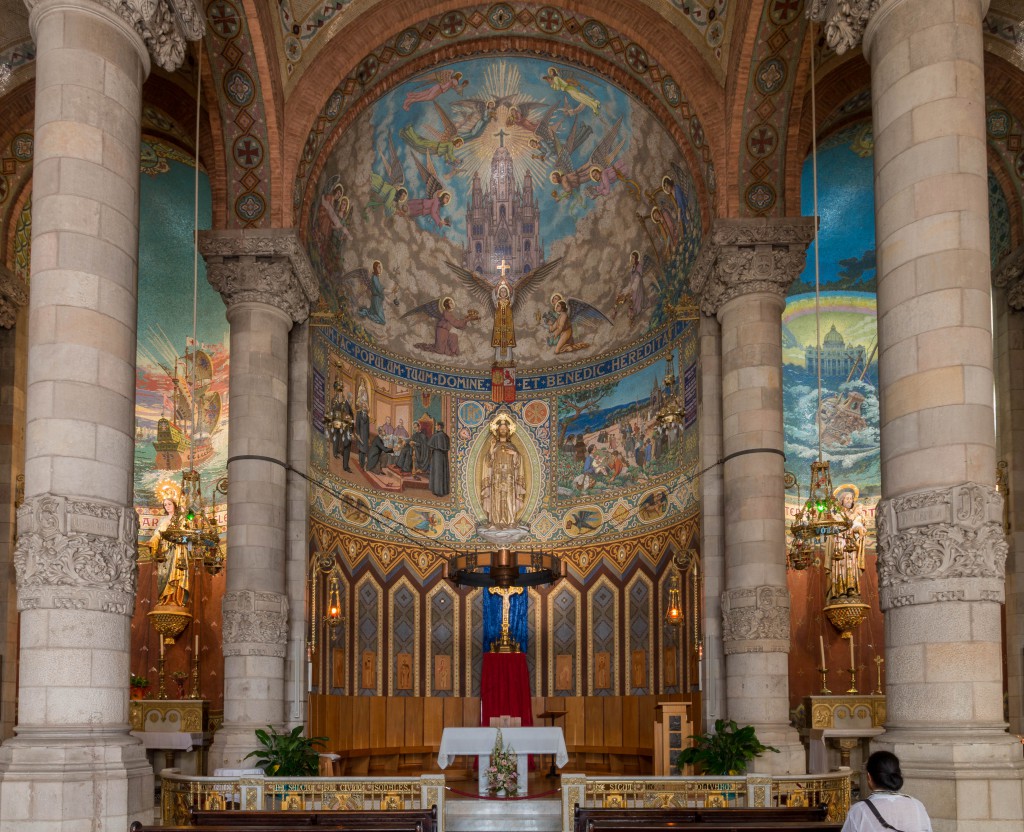
FROM:https://en.wikipedia.org/wiki/Temple_Expiatori_del_Sagrat_Cor
FROM:Templo del Sagrado Corazón de Jesús
FROM:Templo – Temple del Tibidabo (Barcelona) HD
Don’t you think it’s addictive?
Want to know more about the beauty of architecture?
Come and join our members to explore the beauty of architectural design.
覺得看得不過癮嗎?
想要知道更多建築之美嗎?
快來加入我們的會員,一同探索建築設計之美。
The above article is purely for appreciation and sharing purposes, as well as the construction of new technology and the public can be in-depth understanding of the information at the same time there are sources, will be able to query, no use of the document as a commercial transaction, if illegal, please inform the We will immediately remove the site, thank you for cooperation.
以上文章純粹作為欣賞及分享用途,以及將建築新型技術傳遞給與大眾能夠深入了解,同時資料還有來源,將可查詢,絕無使用該文件資料作為商業交易行為,如有違法請務必告知該網站我們將立即處理撤除,謝謝合作。

